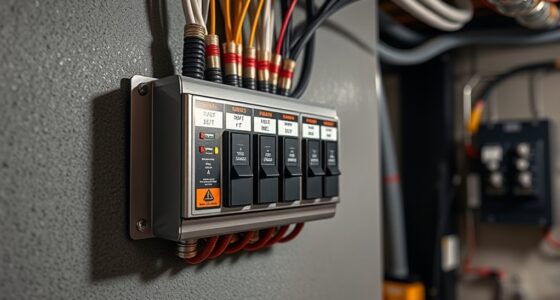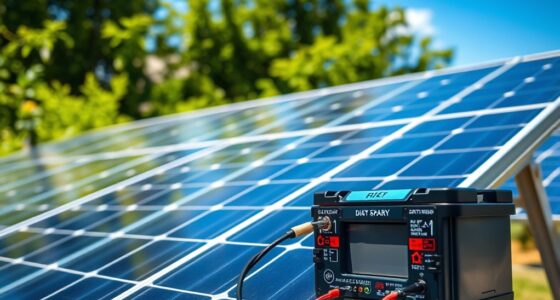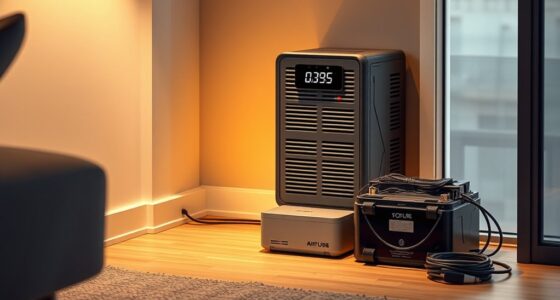Many homeowners believe transfer switches are only needed during outages or that all types are interchangeable. Some think they operate automatically without professional help or can power the entire home seamlessly. Others assume installation is simple DIY work, or that once installed, they require no maintenance. In reality, compatibility, safety, and proper setup matter, and ongoing inspections are vital. To understand what really works, keep exploring how transfer switches can keep your home safe and reliable.
Key Takeaways
- Transfer switches are not only for outages; they can work with various power sources like solar and batteries for everyday safety.
- Not all transfer switches are compatible with every generator or power system; proper matching is essential.
- Installation by homeowners is possible but risky without proper electrical knowledge and adherence to safety standards.
- Automatic transfer switches do not handle all loads automatically; manual override may be necessary for certain appliances.
- Regular visual inspections and testing are minimal but vital for long-term reliability and safety of the transfer switch.
Transfer Switches Are Only Necessary During Power Outages
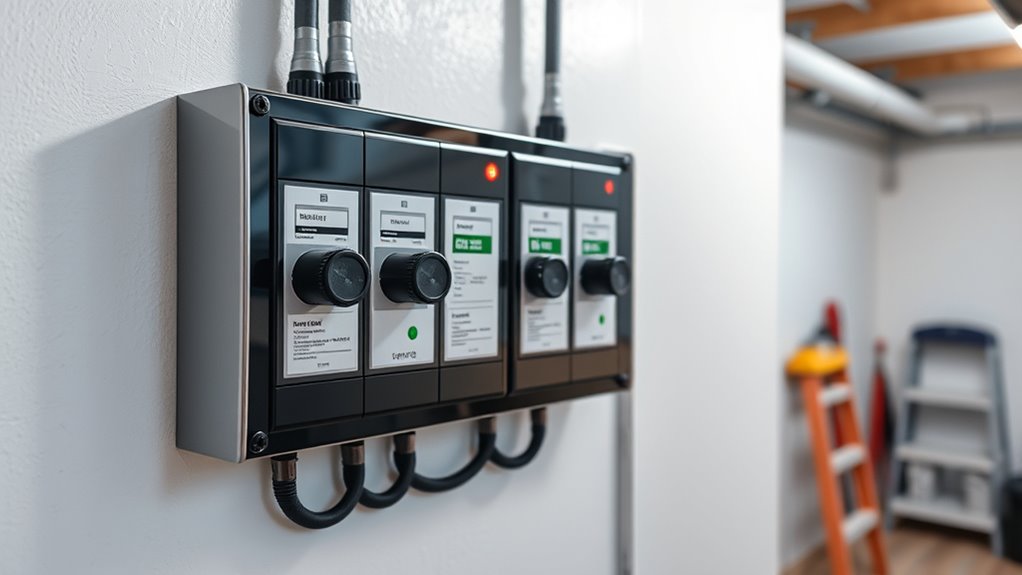
Many homeowners believe that transfer switches are only useful during power outages, but this isn’t entirely true. Transfer switches are essential for managing generator compatibility and ensuring safe power distribution, regardless of whether the grid is active. They work with various power source types, including portable generators, standby generators, and even solar systems. By switching between your main utility and backup power, a transfer switch helps prevent back-feeding into the grid, protecting utility workers and your equipment. Even when the power is steady, a transfer switch provides convenience and safety, allowing you to seamlessly switch sources without manually plugging and unplugging cords. Additionally, understanding the signs of spoilage of backup power sources can help you maintain a safe and reliable system. So, don’t limit their use to outages — transfer switches are a crucial part of a flexible, safe home power system.
All Transfer Switches Are the Same and Interchangeable

Not all transfer switches are created equal, and assuming any switch will work for your home can lead to safety risks and compatibility issues. Different homes require specific transfer switch compatibility based on their electrical setup and power needs. Using an incompatible switch may cause malfunctions or even hazards during operation. Additionally, transfer switch durability varies widely; a cheap or poorly made switch might fail prematurely, leaving you vulnerable during outages. It’s crucial to choose a switch designed for your system’s requirements, ensuring it can handle your power load and withstand frequent use. Rushing into a generic option can compromise safety and reliability. Always consult a professional to select a transfer switch that matches your home’s specifications for ideal performance and peace of mind. Considering risk assessment can help identify potential issues before installation.
Automatic Transfer Switches Can Operate Without Professional Installation
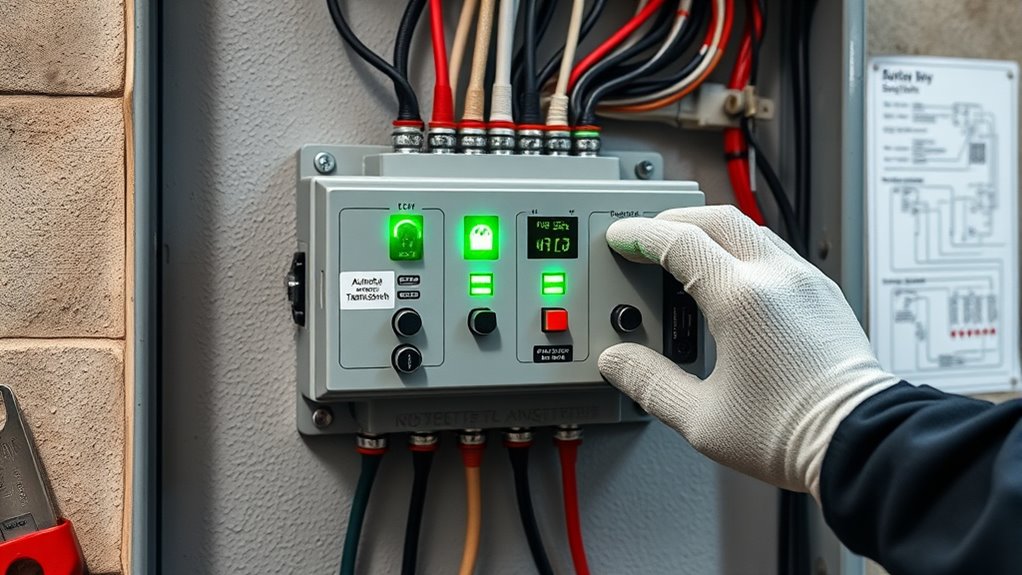
While automatic transfer switches can be installed by homeowners, attempting a DIY setup comes with risks if you’re not familiar with electrical work. Incorrect installation can lead to safety hazards or code violations that may cause issues during inspections. Always guarantee you follow local regulations and consider professional help to keep your system safe and compliant. Additionally, understanding Cultural Intelligence can enhance your ability to communicate effectively with professionals and inspectors from diverse backgrounds, ensuring smoother installation processes and compliance.
DIY Installation Risks
Automatic transfer switches are designed to simplify backup power, but attempting to install one yourself can lead to serious risks. DIY risks include improper wiring, which can cause electrical shocks or fire hazards. Without proper knowledge, you might misconfigure the switch, resulting in unsafe power transfer during outages. Installation safety is critical, and mistakes can put you and your home at risk. Even small errors can lead to equipment damage or dangerous electrical issues. If you overlook safety protocols or skip professional guidance, you could compromise the entire system’s reliability. While installing a transfer switch may seem straightforward, the complexities involved demand expertise. Prioritizing professional installation ensures your safety and guarantees the switch functions correctly when needed. Never underestimate the importance of proper, certified installation for your home’s electrical safety. Additionally, understanding the electrical system and current code requirements is essential for a safe and compliant setup.
Code Compliance Necessities
Proper installation of a transfer switch isn’t just about safety; it also involves following specific electrical codes and regulations. Ensuring code compliance is essential to meet safety standards and avoid legal issues. Electrical codes specify how transfer switches should be installed, grounding requirements, and circuit connections. Failing to adhere to these standards can result in dangerous electrical hazards or equipment damage. While some might think automatic transfer switches can operate without professional installation, improper setup risks violating safety standards and invalidating warranties. Always consult local electrical codes and work with licensed electricians to guarantee your transfer switch is installed correctly. Prioritizing code compliance not only keeps you safe but also ensures your system functions reliably during power outages. Additionally, understanding the importance of home improvement principles can help you plan and execute your installation more effectively.
Transfer Switches Automatically Handle All Electrical Loads
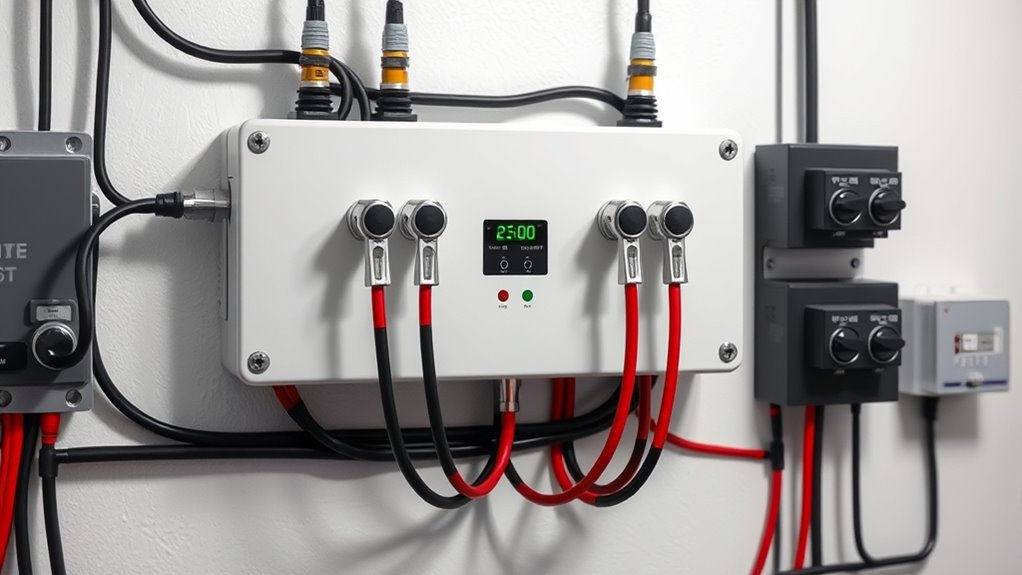
Transfer switches automatically switch all connected loads during a power outage, so you don’t have to manage each device manually. However, automation has limits, and some loads may require manual control or adjustments. Many systems also include manual overrides, giving you control when needed. Additionally, understanding industry trends can help you choose the right transfer switch for your needs.
Automatic Load Switching
When your home experiences a power outage, the switch seamlessly takes over to keep your essential appliances running. Automatic load switching relies on smart switching mechanisms that prioritize critical loads first, ensuring vital systems like refrigeration and medical devices stay powered. The transfer switch continuously monitors power levels and manages load distribution without your intervention. It uses load prioritization to determine which circuits need immediate power and which can be temporarily deferred, preventing overloads. This automation ensures a smooth transition from utility power to backup sources, reducing downtime and avoiding potential damage. Additionally, load management is a crucial aspect of automatic load switching, ensuring that all electrical loads are handled efficiently. By handling all electrical loads effectively, automatic load switching provides peace of mind, allowing you to focus on more important things while your home stays powered during outages.
Limitations of Automation
While automatic transfer switches efficiently manage essential loads during power outages, they have notable limitations. Automation limitations mean not all appliances or circuits are automatically transferred. Many homeowners believe a transfer switch handles everything, but that’s a transfer switch misconception. Non-critical loads, like larger appliances or specialized equipment, often require manual intervention. This can lead to misunderstandings about their capabilities. Here’s a quick comparison:
| Critical Loads Managed by Automation | Not Automatically Transferred |
|---|---|
| Refrigerator | Central AC |
| Essential lighting | Pool pumps |
| Sump pump | Large appliances |
Understanding these limitations helps prevent surprises and ensures you’re prepared for what automation can and cannot do during outages. Additionally, knowing the Kia Tuning options can enhance your vehicle’s performance, but it’s important to recognize that such modifications don’t influence your home’s electrical system or transfer switch capabilities.
Manual Overrides Possible
Many homeowners assume that modern transfer switches automatically handle all electrical loads during an outage, but that’s not entirely accurate. Some transfer switches include a manual override feature, allowing you to take emergency control when needed. This manual override gives you the ability to switch loads on or off directly, bypassing automatic functions in case of maintenance or system issues. It’s especially useful during emergencies, giving you quick control without waiting for automatic processes. Not all transfer switches have this feature, so it’s important to check before purchasing. The manual override ensures you retain safety and flexibility, giving you peace of mind knowing you can intervene physically if necessary. It’s a valuable addition for homeowners wanting extra control during power interruptions.
A Transfer Switch Can Power Your Entire Home Seamlessly
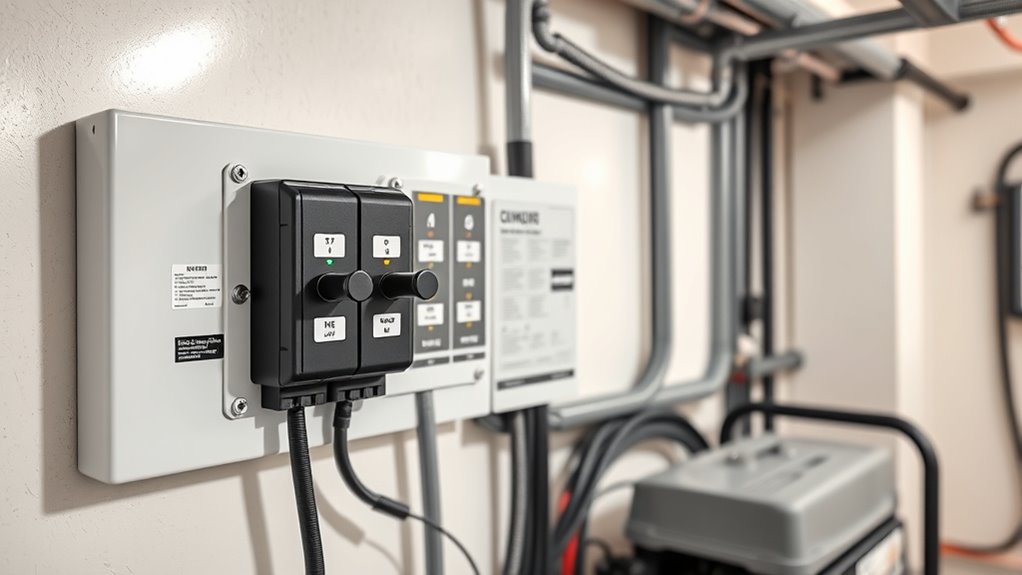
A transfer switch can automatically and seamlessly power your entire home during an outage, eliminating the need to manually select which circuits to operate. It works with your generator, ensuring compatibility so you can run essential appliances without hassle. Proper load management prevents overloads, balancing power distribution across circuits. This means you won’t have to worry about overloading the system or losing power unexpectedly. Instead, the switch detects power loss and switches to your generator quickly, restoring full home function smoothly. Smart load management ensures the system operates efficiently and safely during power transitions.
The Size of the Transfer Switch Doesn’t Matter as Long as It Fits

The size of your transfer switch is less important than making sure it handles your power needs safely and reliably. It must meet safety standards and comply with local codes to protect your home and family. Plus, choosing a switch that fits your current setup allows room for future upgrades without hassle. Proper system compatibility is essential to ensure seamless operation and safety.
Proper Power Handling
While the physical size of a transfer switch might seem important, what truly matters is its ability to handle your home’s power demands. You need a switch rated for your total electrical load to prevent issues during outages. A switch that’s too small can cause dangerous power surges or fail to meet electrical codes, risking damage to appliances or safety hazards. To ensure proper power handling, consider these factors:
- Match the switch’s amperage rating to your main breaker
- Account for peak power loads during startup of appliances
- Follow local electrical codes for transfer switch specifications
- Avoid overloading the switch with unnecessary circuits
- Ensure it can handle future power needs as your home evolves
Proper power handling keeps your system safe, compliant, and reliable.
Safety and Compliance
Although it might seem that the size of your transfer switch is the most important factor, safety and compliance depend on choosing a model that meets your local electrical codes and standards. A properly rated transfer switch ensures fire safety by preventing electrical faults that could cause fires. It’s essential to obtain the necessary electrical permits before installation, confirming the unit complies with safety regulations. Skipping permits or selecting an undersized or non-compliant switch can lead to electrical hazards, code violations, and potential insurance issues. Always verify that your transfer switch is approved by relevant safety organizations and installed by a qualified electrician. Prioritizing safety and compliance helps protect your home, family, and property from avoidable electrical dangers.
Future Expansion Flexibility
Size isn’t as critical as you might think, as long as your transfer switch fits your current setup and future plans. A switch with future expansion in mind allows you to add circuits or load management features down the line. This flexibility guarantees you won’t need a complete upgrade later, saving time and money. When planning for future expansion, consider:
- The potential increase in connected loads
- Compatibility with additional circuits
- Space for extra wiring
- Load management capabilities
- Ease of integration with new systems
Choosing a slightly larger transfer switch now means you’re prepared for growth without hassle. It’s about balancing current needs with future-proofing, making sure your system can evolve as your home’s power demands grow.
Transfer Switches Are Only Compatible With Generators
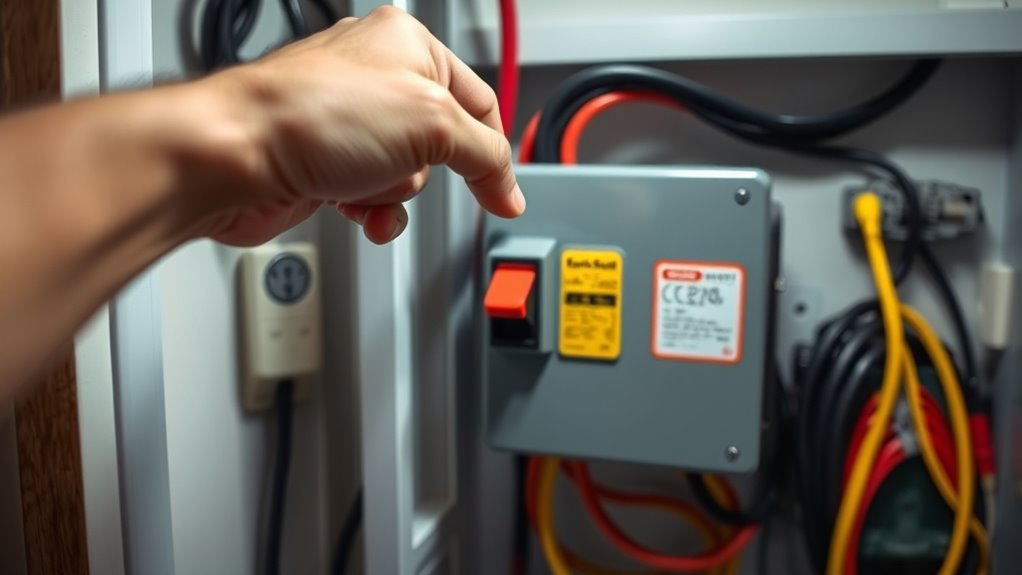
Transfer switches are designed specifically to work with generators, ensuring a safe and seamless power transfer during outages. However, many believe they’re only compatible with generators, which isn’t true. Transfer switches can also work with other power sources like battery systems or alternative energy setups, enhancing your home safety. They prevent back-feeding and electrical hazards by isolating the power source.
| Power Source | Compatibility | Usage Focus |
|---|---|---|
| Generators | Fully compatible | Primary backup power |
| Battery Systems | Some models | Emergency power backup |
| Solar/Inverters | Varies | Renewable energy backup |
Knowing your transfer switch’s compatibility helps you make smarter, safer choices for your home.
Installing a Transfer Switch Is a Simple DIY Project

Installing a transfer switch can be a straightforward project for homeowners with basic electrical knowledge. With proper planning and attention to manual safety, you can guarantee a smooth installation that’s compatible with your generator. Before starting, check that your transfer switch matches your generator’s specifications for compatibility. Keep these key points in mind:
- Turn off main power before beginning
- Use insulated tools to prevent shocks
- Follow manufacturer instructions carefully
- Verify generator compatibility to avoid issues
- Test the switch thoroughly after installation
While it might seem complex, installing a transfer switch doesn’t require extensive electrical experience if you prioritize safety and follow proper procedures. Remember, a correctly installed transfer switch provides a reliable power source during outages, giving you peace of mind.
Transfer Switches Eliminate the Need for Manual Shutdown Procedures
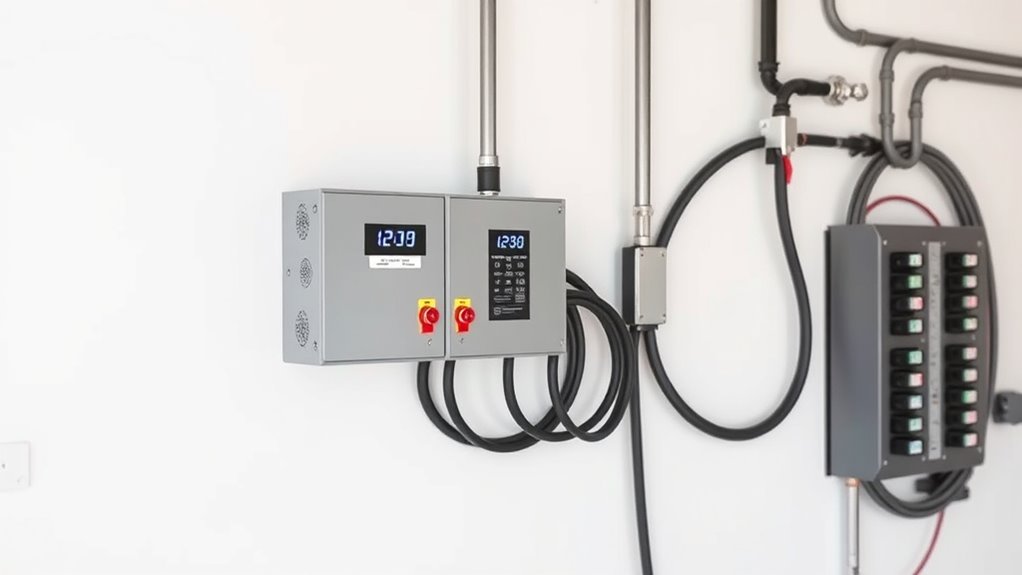
Because of their automatic operation, transfer switches eliminate the need for you to manually shut down your main power source before switching to backup power. Without a transfer switch, you’d have to perform manual operation, which involves turning off the main breaker and carefully managing power cycling to avoid electrical hazards. This process can be time-consuming and risky, especially during emergencies. Transfer switches handle this seamlessly, detecting outages and switching loads instantly. This automation not only saves you from the hassle of manual shutdown procedures but also reduces the chance of operator error. You no longer need to worry about accidental back-feeding or improper power cycling. Instead, the transfer switch ensures a safe, smooth transition, giving you peace of mind during power interruptions.
Once Installed, Transfer Switches Require Little to No Maintenance
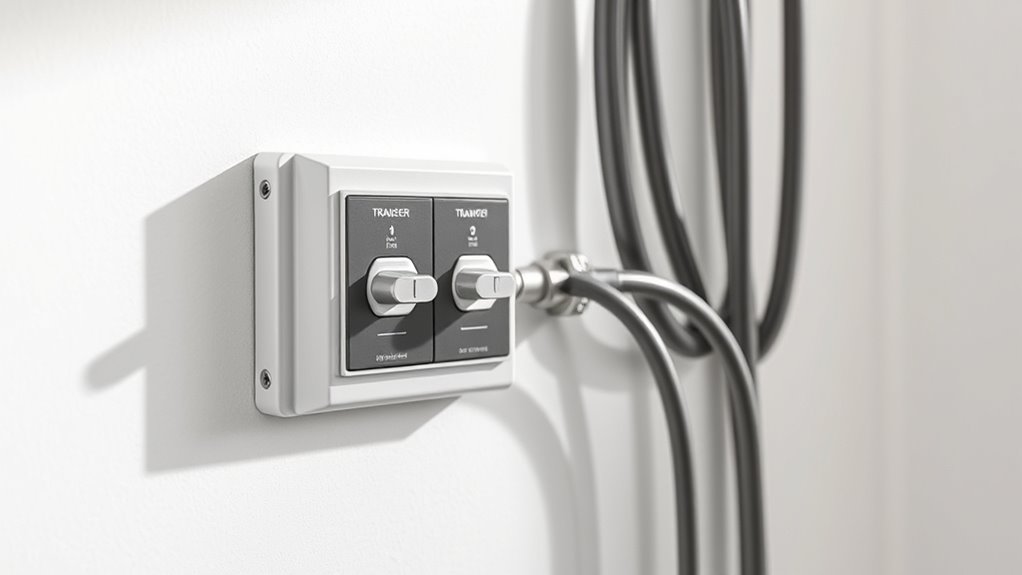
Once your transfer switch is in place, it requires minimal upkeep to keep it functioning properly. Typically, maintenance requirements are low, so you won’t need frequent inspections or repairs. The main purpose is ensuring it operates smoothly during a power outage necessity. Regular checks are simple, often involving visual inspections for wear or corrosion. You might occasionally test the switch to confirm it activates correctly, but extensive maintenance isn’t needed. Properly installed, transfer switches are designed for reliability and durability. Keep in mind, the lack of frequent upkeep doesn’t mean neglect—basic upkeep ensures longevity. Overall, once installed, your transfer switch offers peace of mind with little to no ongoing maintenance, making it a practical choice for reliable backup power during outages.
- Visual inspections for corrosion or damage
- Testing activation during scheduled checks
- Ensuring battery backups (if applicable) are functional
- Keeping the area around the switch clear
- Consulting a professional for periodic service
Frequently Asked Questions
Can Transfer Switches Protect My Home’s Electrical System From Surges?
Transfer switches mainly facilitate seamless power transfer during outages; they don’t provide surge protection. For electrical safety and to protect your home from power surges, you need dedicated surge protectors or whole-house surge protection devices. These guarantee your electrical system stays safe from voltage spikes, preventing damage to appliances and wiring. Combining a transfer switch with surge protection gives you extensive electrical safety, safeguarding your home during outages and electrical surges alike.
Are There Different Types of Transfer Switches for Various Home Sizes?
Did you know that larger homes often require more robust switch types? Yes, there are different switch types designed for various home sizes, from small apartments to sprawling estates. Smaller homes typically use manual transfer switches, while larger residences benefit from automatic or sophisticated switch types that handle higher power loads. Selecting the right switch type guarantees safety, reliability, and seamless power backup, tailored perfectly to your home size needs.
How Long Does It Typically Take to Install a Transfer Switch Professionally?
Installing a transfer switch typically takes about 4 to 8 hours, depending on your home’s electrical complexity. The installation timeline can vary based on the specific transfer switch model and your existing setup. You need a licensed electrician to meet professional requirements, ensuring safety and code compliance. Rushing the process isn’t advisable—you want a thorough, proper installation to guarantee reliable backup power during outages.
Do Transfer Switches Require Regular Inspection or Testing?
Yes, you should perform regular maintenance checks and testing on your transfer switch to guarantee it functions correctly during an outage. Typically, testing frequency is recommended at least once a year, but it can vary based on the manufacturer’s guidelines. Regular inspections help identify potential issues early, preventing failures when you need it most. Stay proactive with maintenance to keep your transfer switch reliable and your home protected.
Can a Transfer Switch Be Used With Renewable Energy Sources Like Solar Panels?
Did you know that over 30% of homeowners with renewable energy systems want better solar compatibility? Yes, a transfer switch can be used with renewable energy sources like solar panels, facilitating renewable integration. It’s designed to safely switch power sources, so you can seamlessly run your home on solar or backup power. Just verify your transfer switch is rated for renewable systems and consult a professional for proper setup and safety compliance.
Conclusion
Don’t assume transfer switches are only for emergencies or that they’re complicated to install. For example, imagine losing power during a storm—your transfer switch kicks in seamlessly, keeping your fridge and lights on without manual effort. With proper installation and maintenance, you’ll rely on your transfer switch whenever needed, providing peace of mind and uninterrupted comfort. So, get informed and consider a transfer switch as a smart, reliable addition to your home’s electrical safety.


